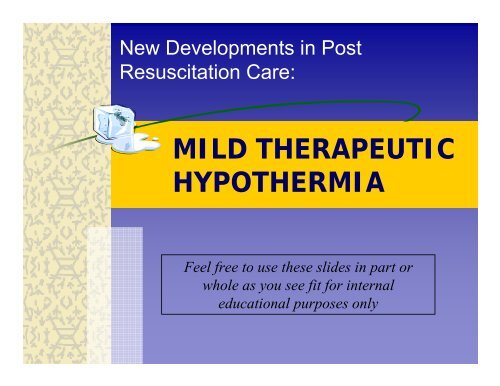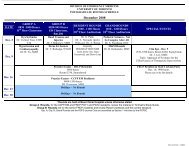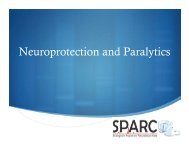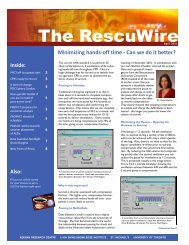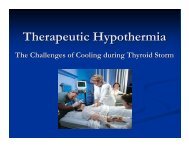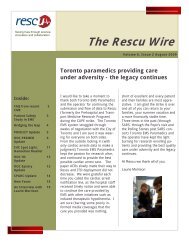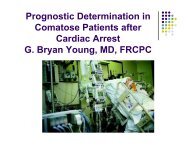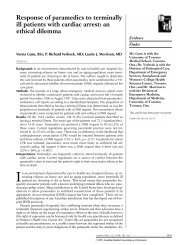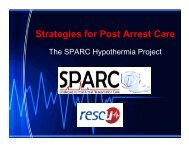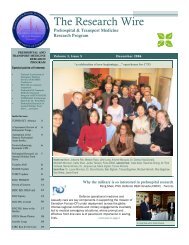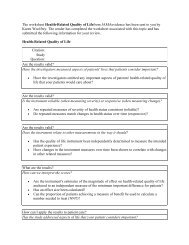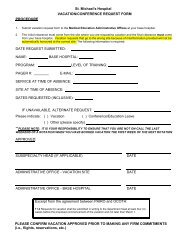MILD THERAPEUTIC HYPOTHERMIA - Emergency Medicine
MILD THERAPEUTIC HYPOTHERMIA - Emergency Medicine
MILD THERAPEUTIC HYPOTHERMIA - Emergency Medicine
- No tags were found...
Create successful ePaper yourself
Turn your PDF publications into a flip-book with our unique Google optimized e-Paper software.
New Developments in PostResuscitation Care:<strong>MILD</strong> <strong>THERAPEUTIC</strong><strong>HYPOTHERMIA</strong>Feel free to use these slides in part orwhole as you see fit for internaleducational purposes only
Resuscitation After Cardiac Arrest:A 3-Phase Time-Sensitive ModelThe Electrical Phase: 0 – 4 min post VF onset‣ if defibrillation achieved, excellent outcomes‣ little need for ventilation, drugsThe Circulatory Phase: 4 - 10 min post VF onset‣ cardiac, CNS hypoxia‣ poor organ function even if defibrillation achieved‣ provide circulation to ‘prime the pump’, ± adjuncts‣ refibrillation common – consider antiarrhythmicsWeisfeld et al,JAMA2002;288:23The Metabolic Phase: > 10 min post VF onset‣ consider hypothermia‣ is epinephrine harmful?
Improving ACLS• Delaying defibrillation (CPR first)• Improving CPR- better thoracic vacuum duringdecompression• Mono vs. biphasic defibrillation• Constant vs. incrementing energy defibrillation• Vasopressors− epinephrine− vasopressin• Antiarrhythmic drugs
But what about the 4 th Link…1234…Post Resuscitation Care
Why do we need to improveour care in the 4 th Link?• Only 10% of cardiac arrests that arriveat hospital alive survive to go home !• About 60% of cardiac arrest survivorsregain consciousness• 1/3 experience irreversible cognitivedisabilities…this is where therapeutic hypothermiahas its effect
Mild Therapeutic Hypothermia• The goal of therapy =– initiate within 2-4 hours of return ofspontaneous circulation– target core temperature of 32-34°C reachedwithin 6 hours after initiation of treatment.• Theory is based in its ability to prevent thecascade of events following a cardiac arrestwhich inhibit neurologic functioning
Plattner O et al,“Efficacy ofIntraoperativeCooling Methods”,Anesthesiology:Volume 87(5)November 1997 pp1089-1095Prior Studies of Cooling*
How Does Hypothermia ProtectAgainst Ischemic Damage?
How It Is Thought to Work• Slows ongoing hypoxic neurologic damagefollowing cardiac arrest• Several mechanisms:– Reduces cerebral metabolic rate– Suppresses free radical production– Suppresses excitatory amino acid release– Suppresses calcium shifts• Effects recognized since the 1950’s
Clinical StudiesRCT’s• Bernard S et al – NEJM 2002; 346(8)• Holtzer M et al – NEJM 2002; 346 (8)Other Designs• Benson D et al – Anaes Analg 1959; vol 38• Bernard S et al – Ann Emerg Med 1997; 33(2)• Bernard S et al – Resuscitation 2003; 56(1)Meta-analysis• Holtzer M et al – Crit Care Med 2005; 33(2)
Post-Resuscitation TherapeuticHypothermiaPatients cooled to 33ºC after resuscitation60%40%20%Survival withNormothermicRecoverySurvival withHypothermicrecovery0%Holzer et al [1] Bernard et al [2][1] Holzer et al, NEJM 2002; 0.3C/hr cooling with cold air and ice packs[2] Bernard et al, NEJM 2002; 0.9C/hr cooling with ice packs
Neurological Outcome &Survival at 6 months60P=0.009P=0.025040Percent (%)3020NormothermiaHypothermia10RR=1.40RR=0.740Favorableneurologic outcomeDeathNEJM 2002, 346:549
LRS Vienna Studies - ResultsLRS ThermoSuit Cooling Performance in Post-Resuscitation Swine Model (Typical Case)BrainPulmonary Artery3837Temperature (degrees C)363534333231300 10 20 30 40 50 60Time (minutes)
LRS Vienna Clinical Study - Results
Rosomoff HLAnn Surg; 1954(179):85-88Hypothermia and CMRO 2
International Support• International Liaison Committee onResuscitation (ILCOR)• American Heart Association (AHA)• European Resuscitation Council (ERC)• Utstein Research Group
An Evolving Standard of CareAHA GuidelinesNov 2005 - New treatmentrecommendations adopted :CIRCULATIONAHA :105,166560 V1 (1).– Unconscious adult patients with spontaneouscirculation after out-of-hospital cardiacarrest should be cooled to:– 32°C to 34°C– for 12 to 24 hours when the initial rhythm wasventricular fibrillation (VF).– Such cooling may also be beneficial forother rhythms or in-hospital cardiac arrest.(Level of Evidence: IIb)
So who should get cooled?• Greater than 18 years of age• Non-traumatic cardiac arrest due toventricular fibrillation or pulselessventricular tachycardia• return of spontaneous circulationwithout full neurological recovery(i.e. comatose)
Who should not get cooled?• Pregnancy• Severe cardiogenic shock• Primary coagulopathies• DNR status• Coma unrelated to cardiac arrest• Received CPR greater than 45 minutes• Suffered a cardiac arrest that is not due to primaryVF or Vtach (e.g. PEA, asystole, non-cardiac, etc)
Various Cooling MethodsThese differ greatly by time to cool & cost:Ice bags at axillae & groinRapid infusion of cold salineCooling BlanketThermoSuitIce Bath (Artic Sun)Neural Cooling deviceEtc
What does the treatmentinvolve?• Temperature goal 32˚ -34˚ C. within 2-6 hours.• Monitor temperature with esophageal probe Q1h• MAP goal 60-80 mm/Hg• Maintain HOB at 30 ˚ C elevation.• No heated humidification on the ventilator• Maintain PO2 90 – 100 mmHg• Maintain pH within normal range• Begin enteric feeding as soon as practical.• Passively re-warm (no heating blanket) after 24hours of cooling has been completed.
Example of a Hypothermia ProtocolOut-of-hospital Cardiac ArrestIn-hospital Cardiac ArrestPre-alert from EMSTriage RN informs Major MDMajor MD / Change RN pagesMSICU resident on-callMajor MD & MSICU residentidentify study candidateCardiac Arrest Team respondsCardiac Arrest Nurse Specialistidentifies possible study candidateEligibility confirmed by MSICU residentwith on-call Principal InvestigatorMSICU resident pages ThermoSuit ExpertVerify bed availability with MSICU charge nurse & begin TSS set-upIn use atSt. Michael’sHospital,Toronto.Ongoing patient care as per current standards, then transfer patient to MSICUFill in physician orders (MSICU Admission orders)to include: hypothermia using TSS, sedation, paralysis etc…
The S.P.A.R.C. Project!• Network of 43 Ontario hospitals• Focusing on improving the use of hypothermia inpost-arrest patients – other best practices to follow• Provides access to resources such as:– Up to date evidence reviews– Standardized protocols– Implementation tools– Education tools– Data collection and feedback– Networking & sharing experiences with other hospitalsGet Involved in SPARC Today!
Be a “Cooling Champion”!”Never doubt that a group ofthoughtful, committedpeople can change theworld.Indeed, it is the only thingthat ever has.”- Margaret Mead


